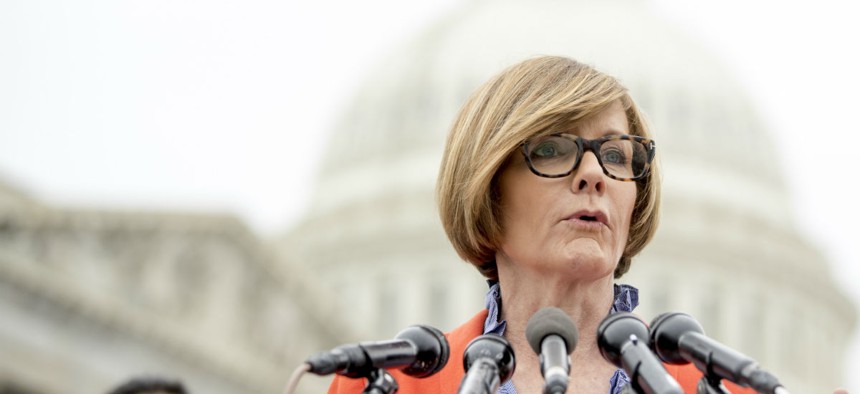After CIO No-Show, Congress Not Confident in VA’s IT Shop

Rep. Susie Lee Andrew Harnik/AP
The Veterans Affairs Department earned no goodwill when it declined to testify before a House Veterans’ Affairs subcommittee.
The House Veterans’ Affairs Subcommittee on Technology Modernization’s first hearing of the session got off to an awkward start Tuesday after the Veterans Affairs Department declined to make Chief Information Officer James Gfrerer or any other official available to testify.
The new subcommittee, created specifically to oversee VA’s multibillion IT upgrades, had planned to assess the department’s Office of Information Technology, which oversees an IT budget of more than $4 billion and is responsible for securing the department’s networks.
“There’s an empty chair where the VA CIO should be sitting,” said subcommittee Chairwoman Susie Lee, D-Nev.
Lee said Gfrerer refused to testify before the subcommittee because he planned to testify before the full House Veterans Affairs Committee later in the day. However, Lee said VA could have provided a deputy or other OIT representation. In any case, the empty chair earned ire from lawmakers on both sides.
Ranking Member Jim Banks, R-Ind., said he was “surprised and disappointed” by the no-show and Rep. Julia Brownley, D-Calif., added, “If they’re not here today, it’s very hard to have any confidence or trust that VA is doing what they should be doing.”
The oversight officials who testified at the hearing pointed to a host of problems at VA OIT, including with its 10-year, $10 billion electronic health records modernization, its most high-profile effort. The goal is for VA to have the same commercial health records platform as the Pentagon, but Carol Harris, director for IT acquisition management for the Government Accountability Office, told lawmakers it will be a pipe dream if the Interagency Program Office doesn’t work.
The IPO was created by Congress in 2008 as a single point of accountability for the two agencies’ electronic health records exchanges. However, VA failed on all three previous efforts at modernizing its health records systems, costing taxpayers billions, and the current IPO isn’t showing signs of functioning properly, either.
“I think you have two departments unwilling to relinquish control to a third party to make decisions,” said Harris. “If DOD and VA cannot formalize a process for how to adjudicate these tough issues, they are going to fail again in their fourth attempt. When the wheels start falling off the bus, we have to be able to ID who is responsible to effectively correct actions.”
Banks said he was beginning to circulate legislation that would charge the IPO with “all aspects of interoperability” between Defense and VA, and that he’d share it with GAO for recommendations.
“The IPO is not living up to Congress’ idea for a single point of contact,” Banks said.
CIO Turnover, Poor Program Management and Lax Security
Officials from VA’s Office of Inspector General identified CIO turnover as another of the department’s major problems. VA has had six CIOs since 2012 and five CIOs in the last four years. Even with a permanent CIO in place—as the VA has now—Michael Bowman, director of the IT and Security Audits Division at VA OIG, said the VA CIO “is not actively involved in planning or budgeting in IT within all of the enterprise.”
“Combine that with frequent turnover, and it’s a recipe for disaster,” Bowman said.
Brent Arronte, deputy assistant inspector general, told the subcommittee that prior audits have identified numerous VA medical centers circumventing the VA CIO to purchase IT. This can have major security ramifications.
“What we find is medical centers purchasing medical equipment under their own budgets,” Arronte said. “The CIO is unaware this equipment is purchased, and there’s no process to ensure the security of the equipment is in place because the CIO was not aware of it.”
In addition, Bowman said IT security controls continue to be a major problem for VA. Bowman said audits have identified multiple “mission critical systems” more than two years behind in security patches, and “five or six” network interconnections with third-parties there were “not monitored.”
“Without monitoring, VA does not know whether the systems are infiltrated,” Bowman said.
Finally, Bowman said passwords and other basic IT security controls have been identified annually in IT security audits. He said FISMA audits turn up VA accounts implementing the same passwords for three straight years, and the routine use of default passwords. Default passwords are especially dangerous because they’re passwords known to all who purchase the software from a certain manufacturer.
“We’ve gotta see passwords controls,” Bowman said, adding that it becomes a discussion point with VA leadership every year. “Either our testing is very good or VA is very lax.”
Bowman said the number of legacy systems “now unsupported by vendors” is also creeping up, making it harder to test systems for vulnerabilities.
“Until you resolve those issues, material weaknesses will remain,” Bowman said.
After listening to the litany of OIT issues from testifying oversight officials, Banks uttered a one-word response.
“Unbelievable,” he said.






